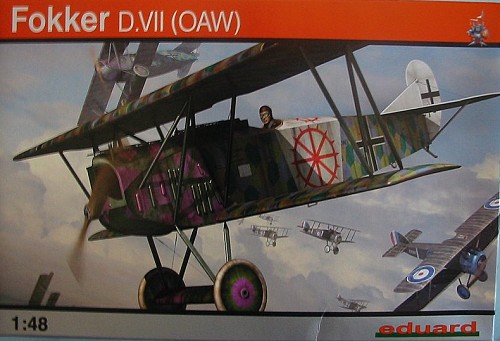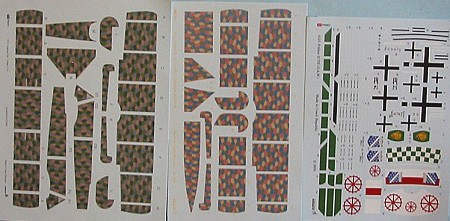
| KIT: | Eduard 1/48 Fokker D.VII (OAW) |
| KIT #: | ? |
| PRICE: | $34.95 MSRP |
| DECALS: | Four options, plus lozenge |
| REVIEWER: | Tom Cleaver |
| NOTES: | Profipak version |

| HISTORY |
When the Fokker D.VII won the First Fighter Competition in January 1918, the German fighter force was in such dire need of the airplane - with its potential to defeat the Allied air superiority on the Western Front - that the service contracted with Fokker to not only produce them at his Johannistal plant, but to have them sub-contracted by his long-time competitor, Albatros. Albatros in turn sub-contracted with their Ostdeutsche Albatros Werke (OAW). In the event, more than half of all D.VIIs built were produced by Albatros, and more than half of those by OAW. The quality of work at the OAW plant was such that the OAW D.VIIs were commonly considered the best of the series by the pilots who flew them in combat.
The OAW-built D.VIIs - following the initial production series which were exactly like the initial Fokker-built D.VIIs - were generally distinguishable by cowling panels that had more louvres than those used by Fokker, in an attempt to deal with the problem of engine cooling, which could lead to the ammunition - carried immediately behind the firewall - “cooking off” in flight, along with in-flight engine fires. There were two different louvre schemes used which distinguished the third and fourth production batches which were the majority of OAW-built D.VIIs. Additionally, OAW used a distinctive green-and-mauve scheme on the cowling panels known as “the giraffe scheme” for the similarity of the markings to the spots on a giraffe. While both Albatros and OAW-built D.VIIs were also built with the superb BMW 185 hp engine, they were not differentiated from the Mercedes-powered aircraft the way Fokker distinguished the BMW-powered D.VIIf.
| THE KIT |
 WW1 Modelers have
wanted a kit of the late-production OAW D.VIIs for a long time. Almost all
D.VII kits produced prior to the Roden kits were of the D.VIIf, the version
built in the smallest numbers of all.
WW1 Modelers have
wanted a kit of the late-production OAW D.VIIs for a long time. Almost all
D.VII kits produced prior to the Roden kits were of the D.VIIf, the version
built in the smallest numbers of all.
Eduard has provided the OAW series with this kit, released with two separate fuselages that come with the differing cowlings, so that a model of any late-production OAW D.VII can be built. Interestingly, the kit arrives about a month after Roden has released the third-production batch OAW and final production batch Albatros D.VII.
So, how do the two kits compare? The Eduard kit is obviously much less
“fiddly” than the Roden kit, due to the fact the cowlings are provided
integral with the fuselage half, rather than separately like the Roden
kit. The Eduard kit is far more crisp in molding than the Roden kit, and
also comes with a photo-etch fret that includes seat belts, attachment
plates, etc., in addition to an instrument panel that comes pre-printed
with a wood pattern. The interplane struts are the thinnest I have ever
seen in a D.VII kit and are as close to scale-thickness as one can get.
Additionally, the Eduard kit
 shows the underlying
frame structure on the fuselage as they did with their Camel kit, and the
wings have molded rib-tape detail. This last is actually too heavy, since
any molded detail of rib tapes in 1/48 is almost guaranteed to be too
heavy. It will, however, look good under either a coat of paint or the
lozenge decals.
shows the underlying
frame structure on the fuselage as they did with their Camel kit, and the
wings have molded rib-tape detail. This last is actually too heavy, since
any molded detail of rib tapes in 1/48 is almost guaranteed to be too
heavy. It will, however, look good under either a coat of paint or the
lozenge decals.
The decals provide the distinctive OAW 4-color lozenge, already cut into the proper sections for application to the airframe. Markings are included for four individual aircraft - two 3rd-batch D.VIIs flown by Hasso von Wedel of Jasta 23s and Franz Buchner of Jasta 13, and two 4th-batch D.VIIs, one flown by Rudolf Start of Jasta 35b and an otherwise-anonymous airplane of Jasta 58.
| CONCLUSIONS |
The. Best. World War I. Model. Ever.
This Eduard D.VII is the Tamiya P-47 of World War I models. The original D.VII “made the average pilot good and the good pilot great.” This model will do the same for modelers. If you have ever wanted a World War I model in your collection but were afraid of their “fiddly” nature, this is the kit for you. I’m not going to go so far as to say it is foolproof, but one is going to have to be very foolish indeed to not end up with a stunner when finished.
That said, this kit does not make the Roden kit obsolete by any matter of means. At a price that is close to half that of the Eduard kit, the Roden kit makes up into a very credible model if one knows the various “secrets” to dealing with its fiddly design. But the Eduard kit is head-and-shoulders above it in the same way the Tamiya P-47 is head-and-shoulders above every other 1/48 P-47 kit. It is definitely not overpriced for what is in the box.
July 2005
Thanks to Eduard for the review kit.
If you would like your product reviewed fairly and quickly by a site that has around 300,000 visitors a month, please contact me or see other details in the Note to Contributors.